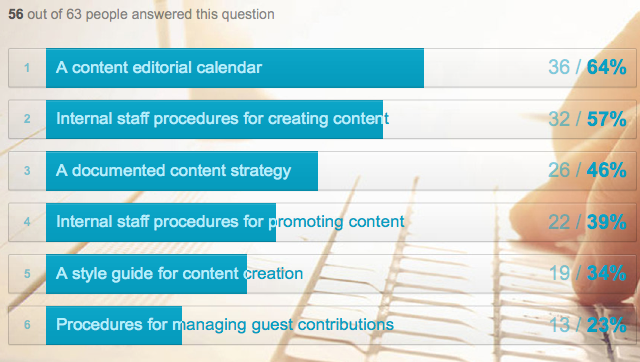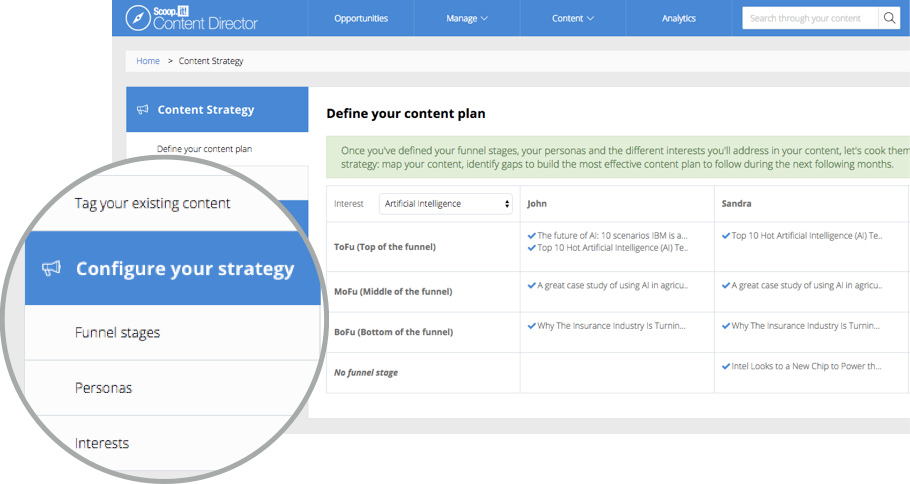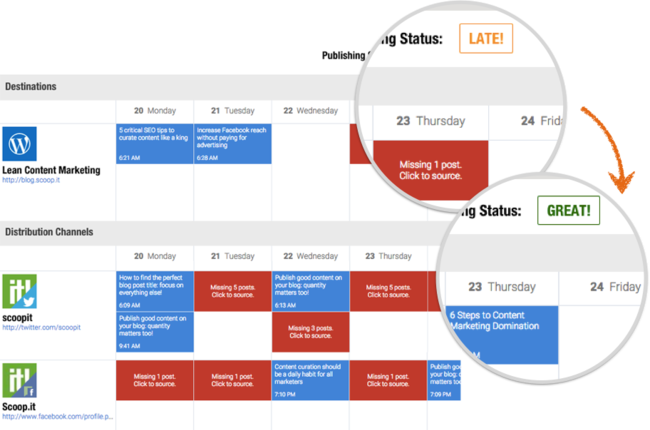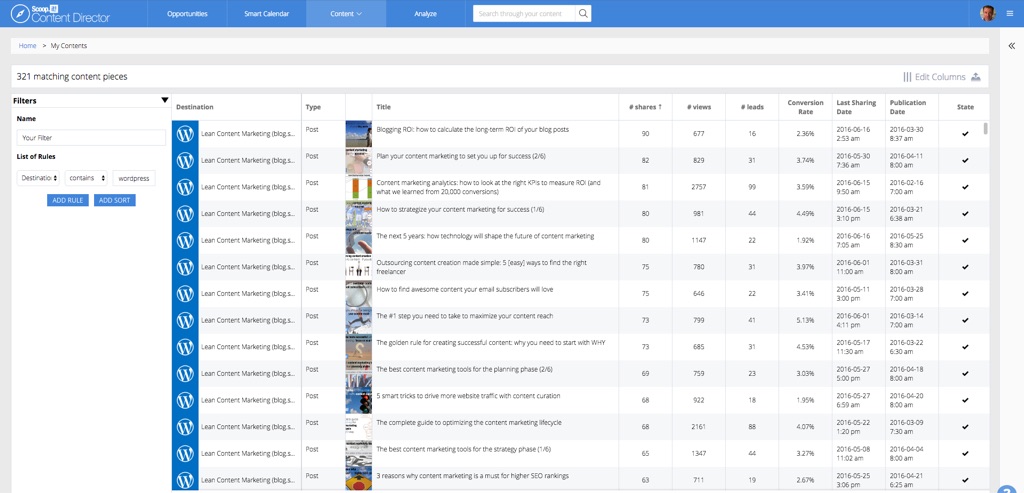
Ever heard of “random acts of content”?
It’s an activity many content marketers fall prey to when they don’t have a coherent content strategy – or they have a content strategy, but they don’t follow it in a disciplined way. Basically, “random acts of content” is when you just publish whatever occurs to you, without any thought to how it aligns with your content strategy or your business goals.
A couple random acts of content aren’t going to get you fired from your content marketing job… but they could cut into your raise or your bonus.
Know why?
Results. Without a strategic, data-based plan for your content, you can create a whole pile of content (even good content), but it may not produce the real point of content marketing: More business – whether that’s in the form of a bigger audience, more exposure for your brand, or leads and sales.
In other words, you’ll risk spending a lot of money without getting any results.
That’s an extreme example of random acts of content and their results. Often, content marketers don’t miss the mark that badly. They mostly make content according to their business goals… but they don’t do it with enough consideration of the buyer’s journey, and how different personas react to different content.
That creates “content gaps”.
Gaps are places in the buyer’s journey where there is no relevant content. A content disconnect, as it were. Those gaps can cause people to disengage with your brand – just when they were happily moving through the sales process.
There’s one other problem with these random pieces of content. They often don’t fit well within your content workflow – the pre-defined process of how content gets created and approved in your company.
Unfortunately, many of the same marketers who don’t even have a documented workflow also don’t have a documented content strategy or an editorial calendar. These three tools tend to mark the difference between the content marketers who can prove positive ROI… and those that can’t.
But back to the content workflow problem with random acts of content: Because these content pieces don’t have a pre-defined way to be created, they often take more time to create.
The people working on these pieces miss their deadlines, causing everyone stress, triggering “rush job” charges, and generally making everyone look less than professional.
Nobody likes that.
The other nasty consequence of these rushed, stress-filled, ill-planned pieces of content? Mistakes. Sometimes, expensive mistakes. Five-figure mistakes – or worse.
Of course, some of these problems are going to happen no matter how well you manage your projects. No matter how diligently you follow content marketing best practices.
Content marketing is tough, after all. You have to find and maintain that sweet spot between publishing enough content to keep your audience engaged, and publishing content of a high enough quality to keep people engaged. It can be done, but it’s a challenge.

Image source: Pixabay
Editorial calendars can make all those problems, challenges and competing goals easier. They can minimize most of the off-strategy content, the stress, the rushed work. And editorial calendars can make you, the content marketer, look like a project management ninja.
But you have to use an editorial calendar to get those results.
Without the calendar, you’re back in “random acts of content” land, rushing through blog post after webinar after eBook, with no planning, poor coordination… and the occasional stinging mistake.
Maybe that’s why most content marketers do use an editorial calendar. 64%, actually. That’s what WP Curve found when they asked a group of startups about their content marketing practices.

We’d like to help you get into that 64%. Because good content marketing is good for your career, your business… and maybe… sometimes… might make the world a better place.
So here are five compelling reasons to be among that 64%.
1. Having an editorial calendar will help you adhere to your content strategy and plan content themes.
Think of an editorial calendar as an action map for your content strategy. It’s one of the ways you spell out how your strategy will be executed. Blog post by blog post, eBook by eBook, down to the details of who will write, who will design, and which channels will be used to promote.
In other words, a content strategy without an editorial calendar is like a dream without a plan. It sounds great, but rarely gets accomplished.
 2. It will help you manage members of your team better.
2. It will help you manage members of your team better.
If you’re a one-person content shop, it’s understandable why you might want to have a minimalistic editorial calendar or even try to get by with no editorial calendar at all.
But as soon as there’s more than one of you – even if there are freelancers in the mix – the need for an editorial calendar gets more pressing. Way more pressing.
As soon as there’s more than one person working on content, the potential for miscommunication, missed deadlines, and overlooked tasks explodes.
Even if you just need your boss to contribute a blog post once a month, having an editorial calendar means their contribution is “on the map”. They’ll be able to see when it’s due, what it’s about and its progress after they’ve submitted a draft.
Add in a graphic designer (who needs to know when a header image is needed, and need to format the final post), and you’ve got another series of tasks to coordinate. Again, your editorial calendar can help with all that.
One other marvelous benefit to all this? Less email! A well-planned editorial calendar that tracks every task and deadline for each piece of content – and lets every contributor know what is due and when – can drastically reduce the number of emails in your inbox.

A robust editorial calendar lets you assign roles and responsibilities to each user.
3. It will help you create better content.
Knocking off a post whenever you feel like it is okay. But if you can save up your best ideas, you’ll create better content.
And you’ll create even better content if you schedule your best content ideas on an editorial calendar. That way, you can group related ideas together into themes – typically monthly themes.
This grouping lets you have the time to research and think about your topic, which in turn makes you more knowledgeable and more authoritative. It gives you the time to add the extra “pixie dust” to your projects before they get published. You know – those last, extra-mile improvements that really make content stand out.
The end result? Content that’s way better than anything you could usually just “knock off” on a whim.
4. An editorial calendar will minimize last-minute deadline work, reducing stress and saving “rush job” costs.
To get the benefits of this, you’ll need an editorial calendar that’s sophisticated enough to have multiple users, and be able to send scheduled reminders to each of those users.
But once that’s set up, you should be able to never have another surprise deadline again.
Really.
Just set the calendar to remind people when things are due. Messages might go out at maybe a week before the deadline, three days before and one day before.
You’ll also need to have your content creation workflow process broken into granular-enough steps so that there is no one step that’s so big that a one-week reminder wouldn’t be enough time for someone to get the task done (even if they already had a very full workload).
The setup for notifications will be a little different for every team. It will require some tweaking to figure out what’s enough heads up time so no one panics.
But once it’s running, all those stressed-up deadline days could be a thing of the past. That means far less stress, and far less expensive “rush job” requests.
Heck… you might even want to use an editorial calendar just for the sake of your health.

5. An editorial calendar will bring all your marketing efforts together.
One of the latest evolutions for editorial calendars is to have one for every major aspect of your content marketing. For example: a social media calendar, a blog calendar, and a webinar calendar.
This will certainly help with project management, but we recommend using an editorial calendar that’s sophisticated enough to let you have information about every channel in one calendar, but that also lets you switch different channels on and off as you see fit. A filter, as it were.
That way your all your information is still in one central hub, but you can filter different marketing channels out if you want to focus on just one.
This gets even more effective if you hook up your editorial calendar to your content inventory, or “content hub”. That way, you’ve got a 360-degree view of your content, how it has performed, and when it might need to be updated or even reformatted or re-shared for more exposure.
Remember: You’ll also want to make space on your calendar for updating old content, and possibly for reformatting some of that old content, too. That ability to make space for projects that might get overlooked is one of the other secret benefits to using an editorial calendar.

Scoop.it Content Director synchronizes your editorial calendar and your content library, so you can more easily manage every element of your content marketing project – including your blog, website, social media accounts, webinars, eBooks and more.
Final thoughts
One of the most challenging things about content marketing is to take our lofty visions of content strategy and audience engagement and break them down into real-world, scheduled tasks. And to do it day after day, with excellence and consistency, no matter what else is going on in the office.
Editorial calendars help define that commitment. Working without one, actually, just won’t cut it anymore.
Why? Because your competition is probably using an editorial calendar. And you need enough clarity and time-management for your own work to avoid burnout, and to turn in A+ content in an efficient way.
But you also don’t have to live and die by what’s on your editorial calendar.
Many of the best content marketers do use calendars to block out major themes – like one theme for every month. But they also build in some flexibility.
So if you like knocking off a blog post now and then when you’re inspired – keep doing that. Just leave a few empty slots in your calendar for those inspired posts, or for a guest post, or for whatever other content marketing experiments you want to try.
This is your editorial calendar, after all. It’s a tool – not an inflexible list of commandments.
Back to you
Do you use an editorial calendar? Leave a comment and tell us whether it has helped or not.
Image by Lightstargod


